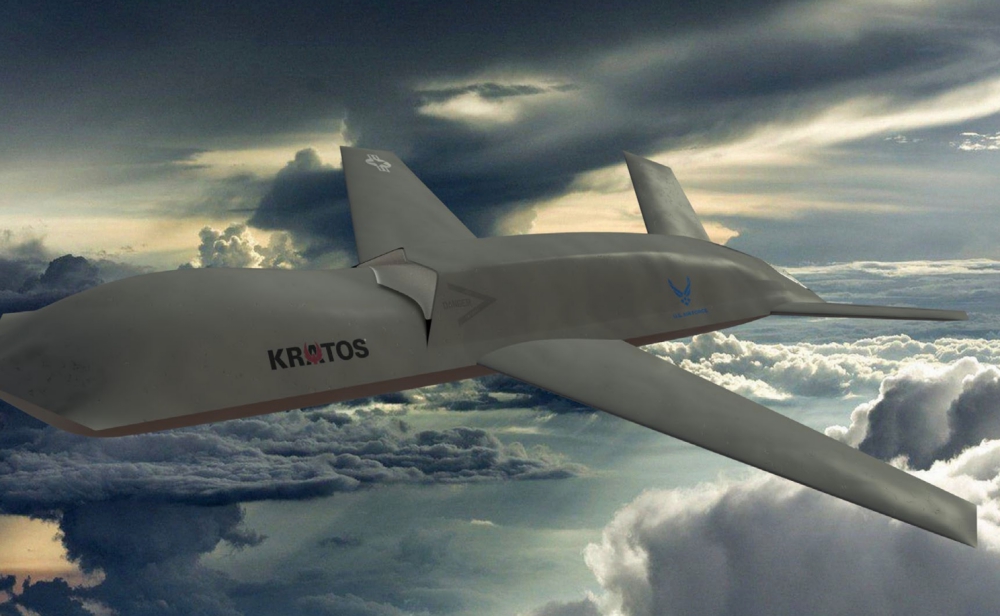Kratos has released the first rendering, above, of the unmanned aircraft it is developing under the U.S. Air Force’s secretive Off-Board Sensing Station program, or OBSS.
While details about the drone remain limited, we do know there is a heavy emphasis on scalability, modularity, and affordability, and that it will leverage advanced design and manufacturing concepts to help achieve these goals. There also may be hints as to what it may be intended to do thanks to recent remarks from one of the company’s executives.
Breaking Defense was the first to publish the artist’s conception of Kratos’ OBSS design, along with an interview with Steve Fendley, the President of the company’s Unmanned Systems Division. In October, the Air Force Research Laboratory (AFRL) awarded Kratos a contract to build and flight test at least one OBSS prototype. General Atomics also received a functionally identical OBSS contract from AFRL, though the value of their deal was different.
From what we can see in the rendering, the drone has a stealthy design with a noticeable continuous chine-line that wraps around the fuselage, as well as a serrated top-mounted air inlet and shrouded engine exhaust. It has a simple swept wing and a broadly splayed v-tail. There are some similarities, especially in the rear two-thirds of the design, to Kratos’ XQ-58A Valkyrie drone, but the OBSS lacks the cranked wing of that design and its tail is differently configured.
There are virtually no details available yet about its expected performance or other capabilities, either. In the interview published by Breaking Defense, Fendley, the President of Kratos’ Unmanned Systems Division, was very careful to speak in generalities, rather than about what OBSS might be capable of specifically.
“In general, that’s correct. However, there’s certainly the possibility of having an attritable aircraft carry an exquisite sensor,” Fendley said in response to a question about whether OBSS would carry a basic payload to help keep its costs down and make it less of a problem if it were to be lost on a mission. “For example, we could integrate a $5 million-$10 million sensor on one of our systems. But that specific tail number, in all likelihood, would not be performing an attritable mission, even though technically the expensive sensor would be on an attritable aircraft.”
Defining the term “attritable” can be difficult. The War Zone has generally described attritable platforms – drones or anything else – as ones designed with a focus on balancing capabilities against lower costs to produce something capable of performing certain missions in higher-risk environments where commanders might be disinclined to employ a costlier and more technologically advanced asset. Fendley, in this new interview, used a definition of a system that costs “$2 million to $20 million per copy” and “provides a high-performance-versus-cost-system solution that the user can afford to potentially lose at some non-zero rate.” The Kratos’ XQ-58A, which the company has long said it hopes will eventually have a unit cost of around $2 million as production expands, would be at the lower end of that target price range.
“The other thing about attritables that’s different from legacy UAS, outfitted with their exquisite sensors, is distributed lethality in the case of weapons and distributed sensing in the case of sensor missions. Maybe you have a very comprehensive sensor capability because you have 10 of these attritable aircraft carrying non-exquisite EO/IR systems, for example,” he continued. “You’re fusing the data you get from those aircraft remotely, and the picture you get is very precise. Now let’s say that three of those aircraft get shot down; you still have a very high-quality picture and good intelligence because you have a seven-sensor baseline instead of just one very expensive sensor. The distributed method helps reduce cost and increase mission effectiveness and survivability.”
“Speaking of attritable aircraft generally, not necessarily OBSS, we’re talking about sensor extension and range extension. Let’s say a manned system has particular sensors, such as EO/IR, and the goal is to increase standoff range against a particular threat,” Fendley added when asked to describe a notional OBSS mission. “A handful of attritable aircraft could fly in a teaming formation with a manned aircraft. As the mission progresses, the pilot in the manned aircraft would say, ‘OK, this is as far as I’m going toward the threat because we’re getting close to a contested environment or risk area for me.’ The unmanned aircraft would then be tasked with continuing into the contested environment/risk area and collecting and sharing data to better inform the mission and the warfighter.”
Source: The Drive

